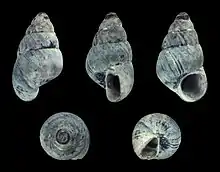| Eatoniella mortoni | |
|---|---|
_mortoni_(Ponder%252C_1965)_(AM_MA71262).jpg.webp) | |
| Holotype of Eatoniella mortoni from Auckland War Memorial Museum | |
| Scientific classification | |
| Domain: | Eukaryota |
| Kingdom: | Animalia |
| Phylum: | Mollusca |
| Class: | Gastropoda |
| Subclass: | Caenogastropoda |
| Order: | Littorinimorpha |
| Family: | Eatoniellidae |
| Genus: | Eatoniella |
| Species: | E. mortoni |
| Binomial name | |
| Eatoniella mortoni Ponder, 1965 | |
| Synonyms[1] | |
| |
Eatoniella mortoni is a species of marine gastropod mollusc in the family Eatoniellidae.[1] First described by Winston Ponder in 1965, it is endemic to the waters of New Zealand. The species has been used to study the effects of ocean acidification, as it is known to thrive in carbon dioxide-rich environments.
Taxonomy
The species was described as Eatoniella (Dardanula) mortoni in 1965 by Winston Ponder, who named it after New Zealand biologist John Morton. Morton had assisted Ponder during his early investigations into the species.[2] Ponder synonymised several previously-named genera, including Iredale's 1915 genus Dardanula, which was retained as a subgenus of Eatoniella.[2]
Description
Eatoniella mortoni has a solid, conical, smooth shell. The shells are widely variable in colour, from purple-tinted dark grey to pale yellow-grey.[2] The species measures 1.85 millimetres by 1.13 millimetres.[3]
Distribution
.jpg.webp)
The species is endemic to New Zealand.[1] The holotype was collected by Ponder himself on 11 December 1961, at Days Bay in Wellington.[4] The species is known to occur on both coasts of the North Island and South Island.[5][2][6][7] In addition, the species can be found on the Chatham Islands[2] and the volcanic island Whakaari / White Island.[8]
Typically the species can be found on algae at low tide,[2] and underneath intertidal rocks,[5] and often lives on kelp species such as Ecklonia radiata.[9]
Ocean acidification studies

Eatoniella mortoni has been used as a species to study ocean acidification, as the species benefits from living in carbon dioxide-rich environments and remains localised,[9][10][11][12] especially specimens sourced from the volcanic island Whakaari / White Island, due to their lifetime exposure to carbon dioxide vents.[13] Eatoniella mortoni can produce more crystalline, durable and less porous shells at natural carbon dioxide vents.[14]
References
- 1 2 3 Bieler R, Bouchet P, Gofas S, Marshall B, Rosenberg G, La Perna R, Neubauer TA, Sartori AF, Schneider S, Vos C, ter Poorten JJ, Taylor J, Dijkstra H, Finn J, Bank R, Neubert E, Moretzsohn F, Faber M, Houart R, Picton B, Garcia-Alvarez O, eds. (2022). "Eatoniella mortoni Ponder, 1965". MolluscaBase. World Register of Marine Species. Retrieved 15 November 2022.
- 1 2 3 4 5 6 Ponder, W. F. (1965). "The Family Eatoniellidae in New Zealand". Records of the Auckland Institute and Museum. 6: 85. ISSN 0067-0464. JSTOR 42906115. Wikidata Q58676802.
- ↑ "Eatoniella mortoni". New Zealand Mollusca. Retrieved 20 November 2022.
- ↑ Blom, Wilma (2022). "Fossil and Recent molluscan types in the Auckland War Memorial Museum. Part 4: Gastropoda (Caenogastropoda – Neocyclotidae to Epitoniidae). [Cyclophoroidea, Cerithioidea, Littorinimorpha]". Records of the Auckland Museum. 56 (55): 39–62. doi:10.32912/ram.2020.55.7. ISSN 2422-8567. S2CID 229670783. Retrieved 20 October 2022.
- 1 2 Hayward, Bruce; Morley, Margaret (2004). "Intertidal Life Around the Coast of the Waitakere Ranges, Auckland" (PDF). Auckland Regional Council. Retrieved 17 November 2022.
- ↑ "Eatoniella mortoni". Auckland War Memorial Museum. Retrieved 17 November 2022.
- ↑ "marine snail, Eatoniella mortoni Ponder, 1965". Te Papa. Retrieved 17 November 2022.
- ↑ "marine snail, Eatoniella mortoni Ponder, 1965". Te Papa. Retrieved 17 November 2022.
- 1 2 Leung, Jonathan Y. S.; Doubleday, Zoë A.; Nagelkerken, Ivan; Chen, Yujie; Xie, Zonghan; Connell, Sean D. (10 July 2019). "How calorie-rich food could help marine calcifiers in a CO2-rich future". Proceedings of the Royal Society B: Biological Sciences. 286 (1906): 20190757. doi:10.1098/rspb.2019.0757. PMC 6650713. PMID 31288703.
- ↑ Doubleday, Zoë A.; Nagelkerken, Ivan; Coutts, Madeleine D.; Goldenberg, Silvan U.; Connell, Sean D. (2019). "A triple trophic boost: How carbon emissions indirectly change a marine food chain". Global Change Biology. 25 (3): 978–984. Bibcode:2019GCBio..25..978D. doi:10.1111/gcb.14536. ISSN 1365-2486. PMID 30500999. S2CID 54568811. Retrieved 16 November 2022.
- ↑ Connell, Sean D.; Doubleday, Zoë A.; Hamlyn, Sarah B.; Foster, Nicole R.; Harley, Christopher D. G.; Helmuth, Brian; Kelaher, Brendan P.; Nagelkerken, Ivan; Sarà, Gianluca; Russell, Bayden D. (6 February 2017). "How ocean acidification can benefit calcifiers". Current Biology. 27 (3): –95–R96. doi:10.1016/j.cub.2016.12.004. ISSN 0960-9822. PMID 28171763. S2CID 46800745.
- ↑ Doubleday, Zoë A.; Nagelkerken, Ivan; Connell, Sean D. (23 October 2017). "Ocean life breaking rules by building shells in acidic extremes". Current Biology. 27 (20): –1104–R1106. doi:10.1016/j.cub.2017.08.057. ISSN 0960-9822. PMID 29065288. S2CID 37459063.
- ↑ Leung, Jonathan Y. S.; Chen, Yujie; Nagelkerken, Ivan; Zhang, Sam; Xie, Zonghan; Connell, Sean D. (2020). "Calcifiers can Adjust Shell Building at the Nanoscale to Resist Ocean Acidification". Small. 16 (37): 2003186. doi:10.1002/smll.202003186. ISSN 1613-6829. PMID 32776486. S2CID 221098469. Retrieved 16 November 2022.
- ↑ Leung, Jonathan Y. S.; Zhang, Sam; Connell, Sean D. (2022). "Is Ocean Acidification Really a Threat to Marine Calcifiers? A Systematic Review and Meta-Analysis of 980+ Studies Spanning Two Decades". Small. 18 (35): 2107407. doi:10.1002/smll.202107407. hdl:2440/136116. ISSN 1613-6829. PMID 35934837. S2CID 251400079. Retrieved 16 November 2022.